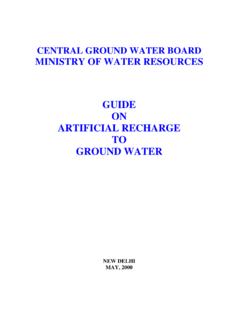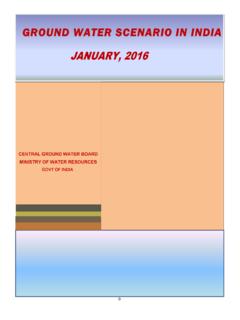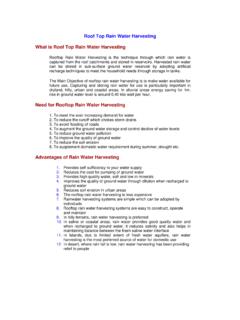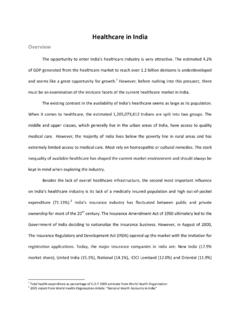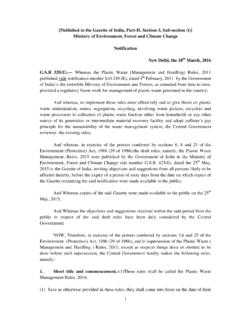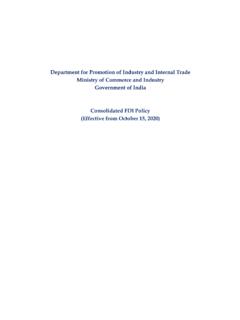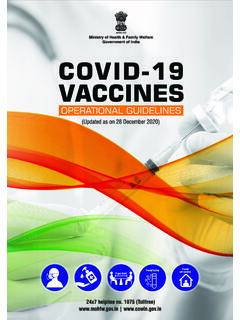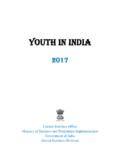Transcription of Central Ground Water Board, Ministry of Jal Shakti ...
1 PREFACEThe dependence on Ground Water as a reliable source for meeting the requirements forirrigation, drinking and industrial uses in india has been rising rapidly during the last fewdecades. Ground Water development has occupied an important place in Indian economybecause of its role in stabilizing agriculture and as a means for drought management. Over theyears, particularly since the launching of Five Year Plans, there have been continued efforts inIndia for development of Ground Water resources to meet the increasing demands of watersupply for various sectors. In many parts of the country, Ground Water development hasalready reached a critical stage, resulting in acute scarcity of the resource. Over- developmentof the Ground Water resources results in declining Ground Water levels, shortage in watersupply, intrusion of saline Water in coastal areas and increased pumping lifts necessitatingdeepening of Ground Water abstraction structures.
2 These have serious implications on theenvironment and the socio-economic conditions of the populace. Worsening Ground waterquality has also adversely affected the availability of fresh Ground Water in several areas. Theprevailing scenario of Ground Water development and management in india calls for urgentsteps for augmentation of Ground Water resources to ensure their long-term sustainability. Thediverse nature of the terrain and complexities of hydrogeological settings prevailing in thecountry makes this a challenging Ground Water Board has been in the forefront of activities for augmenting groundwater resources through scientifically designed artificial recharge structures for harvestingnon-committed surplus runoff which otherwise runs off into sea. A number of pilot schemesand demonstrative artificial recharge schemes have been implemented by the Board inassociation with various State government organizations since the 8th plan period.
3 These areaimed at popularizing cost-effective Ground Water augmentation techniques suitable forvarious hydrogeological settings, to be replicated by other agencies elsewhere in similar on the valuable experience gained from such activities, the Board has also brought outa number of publications on various aspects of artificial recharge. The Manual on ArtificialRecharge of Ground Water is the latest in this series and has updated information on variousaspects of investigation techniques for selection of sites, planning and design of artificialrecharge structures, their economic evaluation, monitoring and technical auditing of schemesand issues related to operation and maintenance of these structures. Roof top rainwaterharvesting, suitable especially for urban habitations is also dealt with in detail.
4 Thispublication will be of immense use to all those who are engaged in planning andimplementation of Ground Water augmentation schemes in various parts of the work done by Central Ground Water Board and other Central , State and non-governmental agencies involved in the Water sector have provided the basic inputs necessaryfor the preparation of this manual. I would like to specially acknowledge the efforts , Commissioner (GW) and Member (SML) (Retd), , , and , Senior Hydrogeologists, inbringing out this hope this manual will be useful to all agencies engaged in planning and implementation ofartificial recharge schemes across the country in a scientific manner to ensure optimumbenefits. Comments and suggestions on various aspects of artificial recharge dealt within thisdocument will be highly appreciated and will be useful for updating the manual in the years 2007 ( ) ChairmanCentral Ground Water BoardManual on Artificial Recharge of Ground .
5 Present Endeavour .. Outline of the Manual .. Global and Indian Water Historical Perspective .. Pre - Independence Scenario .. Post - Independence Scenario .. Efficacy of Ground Water Resource Development .. Emerging Challenges .. Ground Water Depletion .. Ground Water Pollution .. Drinking Water Shortage in urban Areas .. Seawater Ingress in Coastal .. Concept of Need for Artificial Recharge .. Purposes and Principles of Artificial Recharge .. Advantages of Artificial Recharge .. Implementation of Artificial Recharge .. Rainfall .. Measurement of Rainfall .. Rain Gauge Normals of Rainfall Double Mass Curve .. Moving Averages .. Supplementing Data .. Determination of Average Arithmetic Mean Theissen Polygon Method .. Isohyetal Method .. Runoff .. Hydrograph.
6 Estimation of Runoff .. Empirical Formulae and Tables .. Estimation of Direct Runoff from Rational Method .. Empirical Relationships for Determination of Peak Quality of Source Physical Quality .. 39 Manual on Artificial Recharge of Ground Chemical Quality .. Biological Quality .. Establishment of Ground Establishing the Estimation of Sub-surface Storage Capacity of Prioritisation of Areas for Artificial Recharge .. Availability of Source Water .. Suitability of Area for Recharge .. Investigations for Proper Planning .. General Studies .. Detailed Studies .. Appraisal of Economic Viability .. Finalisation of Physical Plan .. Preparation of Report of the Scheme .. Artificial Recharge Techniques .. Direct Methods .. Surface Spreading Flooding .. Ditch and Furrows Runoff Conservation Bench Terracing.
7 Contour Bunds .. Contour Trenches .. Gully Plugs,Nalah Bunds and Check Dams .. Percolation Tanks .. Modification of Village Tanks as Recharge Stream Channel Modification / Augmentation .. Subsurface Injection Wells or Recharge Gravity Head Recharge Recharge Pits and Indirect Methods .. Induced Recharge .. Aquifer Modification Techniques .. Combination Ground Water Conservation Techniques .. Sub-Surface Dykes / Ground Water Dams / Underground Bandharas .. Suitability of Artificial Recharge Structures under Combinations of Factors .. Concept of Roof Top Rainwater Harvesting .. Components of Roof Top Rainwater Harvesting System .. Roof Catchment .. Drain Gutters .. Down Pipe .. First Flush Pipe .. Filtration of Process of 107 Manual on Artificial Recharge of Ground Filter Sand.
8 Classification of Storage Tank .. Size of Storage Tanks for Rural Areas .. Size of Storage Tank for urban Area .. Collection Pump Unit .. Data Requirements for Planning Rainwater Harvesting Systems .. Feasibility of Roof Top Rainwater Harvesting urban Rural Technical Suitability .. Existing Water Sources .. Roof Catchment .. Rainfall .. Space .. Economic Viability .. Social Acceptance of Roof Water as Drinking Water .. Willingness of Households to Traditional Practices of Roof Water Collection .. Water Quality and Bacteriological Water Quality .. Insect Vectors .. Water Treatment .. Analysis of Water Disinfecting Water .. Ready Reconers for Design of Roof Top Rainwater Harvesting Computation of Flow through Half Section Data Requirements for Design of Roof Top Rainwater Harvesting Design Example.
9 Monitoring of Recharge Water Level Water Quality Monitoring .. Evaluation of Existing Water Quality Data .. Pre-operational Monitoring .. Operational Monitoring .. Post-operational Monitoring .. Examples of Impact Assessment .. Catchment Characteristics .. Analysis of Efficiency .. Monitoring of Impact of Impact of Recharge on Chemical Quality of Ground Water .. Impact Assessment of Schemes Completed by 146 Manual on Artificial Recharge of Ground .. Benefit Cost Financial Benefit Cost Measure for Interest and Uncertainties and Sensitivities .. Economic Benefit Cost Analysis .. Conversion Capital and Economic Appraisal .. Social Benefit Cost Analysis .. Socio-economic and Financial Appraisal of Artificial Recharge Schemes .. User Cost .. Steady State Pumping Condition.
10 Artificial Recharge Component .. Recharge Potential of Some Artificial Recharge Structures .. Check Dam & Percolation Tank .. Spreading Channel .. Recharge Tube Underground Dams /Subsurface Financial Outlay .. Benefits of Suggested Measures .. Financial Appraisal of the Profitability Case .. Operational Data Water Level Water Quality Measurement .. Preventive Maintenance .. Maintenance of Surface Recharge Structures .. Potential Problems .. Suspended Material .. Environmental Problems .. Water Quality Problems .. Physical, Biological and Chemical Compatibility of Water .. Physical Compatibility .. Biological Compatibility .. Chemical Maintenance of Roof Top Rainwater Harvesting Tips for Maintenance of the 178 ACKNOWLEDGEMENTS .. on Artificial Recharge of Ground WatervLIST OF of Ground Water Abstraction Structures in india (1982-2001) to Work out Weighted Average Using Theissen Polygon to Work out Weighted Average Rainfall Using Isohyetal s Percentages for Computation of Values of Runoff Coefficients (K) 's Percentage Runoff s Runoff Coefficients for Different Natures of 's Runoff (a)Strange Table Showing Depth of Runoff as Percentage of Total MonsoonRainfall and Yield of (b) Strange Table Showing Daily Runoff of Lacey's Factor (F / S) Hydrological Soil Infiltration Relative Classes of Soil Rainfall Limits for Antecedent Moisture Runoff Curve Numbers for Hydrological Soil Cover of Runoff Coefficient Factor (C)




